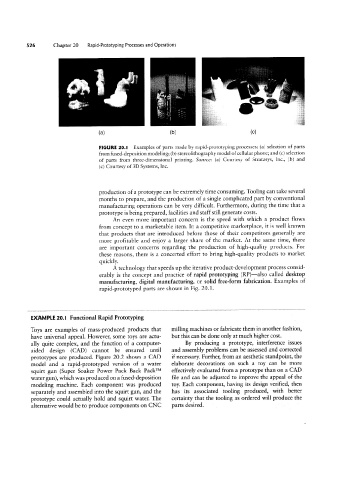Page 546 - 04. Subyek Engineering Materials - Manufacturing, Engineering and Technology SI 6th Edition - Serope Kalpakjian, Stephen Schmid (2009)
P. 546
2 Chapter 20 Rapid-Prototyping Processes and Operations
(H) (D) (C)
FIGURE 20.| Examples of parts made by rapid-prototyping processes: (a) selection of parts
from fused-deposition modeling; (b) stereolithography model of cellular phone; and (c) selection
of parts from three-dimensional printing. Source: (a) Courtesy of Stratasys, Inc., (b) and
(c) Courtesy of 3D Systems, Inc.
production of a prototype can be extremely time consuming. Tooling can take several
months to prepare, and the production of a single complicated part by conventional
manufacturing operations can be very difficult. Furthermore, during the time that a
prototype is being prepared, facilities and staff still generate costs.
An even more important concern is the speed with which a product flows
from concept to a marketable item. In a competitive marketplace, it is well known
that products that are introduced before those of their competitors generally are
more profitable and enjoy a larger share of the market. At the same time, there
are important concerns regarding the production of high-quality products. For
these reasons, there is a concerted effort to bring high-quality products to market
quickly.
A technology that speeds up the iterative product-development process consid-
erably is the concept and practice of rapid prototyping (RP)-also called desktop
manufacturing, digital manufacturing, or solid free-form fabrication. Examples of
rapid-prototyped parts are shown in Fig. 20.1.
EXAMPLE 20.l Functional Rapid Prototyping
Toys are examples of mass-produced products that milling machines or fabricate them in another fashion,
have universal appeal. However, some toys are actu- but this can be done only at much higher cost.
ally quite complex, and the function of a computer- By producing a prototype, interference issues
aided design (CAD) cannot be ensured until and assembly problems can be assessed and corrected
prototypes are produced. Figure 20.2 shows a CAD if necessary. Furthe; from an aesthetic standpoint, the
model and a rapid-prototyped version of a water elaborate decorations on such a toy can be more
squirt gun (Super Soaker Power Pack Back Packm effectively evaluated from a prototype than on a CAD
water gun), which was produced on a fused-deposition file and can be adjusted to improve the appeal of the
modeling machine. Each component was produced toy. Each component, having its design verified, then
separately and assembled into the squirt gun, and the has its associated tooling produced, with better
prototype could actually hold and squirt water. The certainty that the tooling as ordered will produce the
alternative would be to produce components on CNC parts desired.

